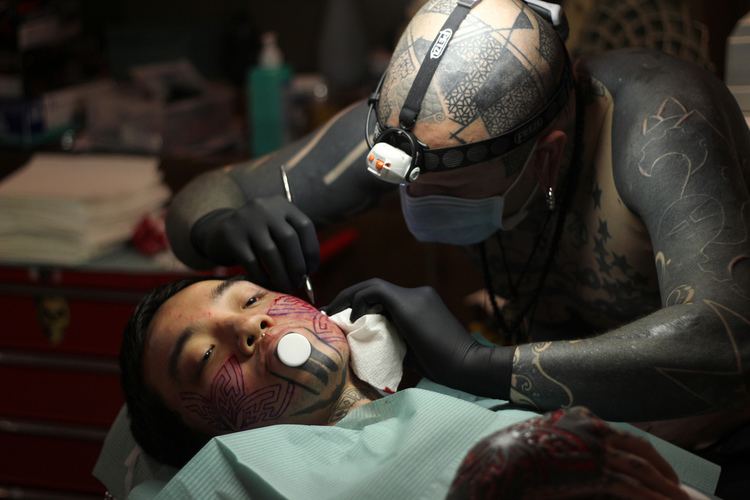Body modification (or body alteration) is the deliberate altering of the human anatomy or human physical appearance. It is often done for aesthetics, sexual enhancement, rites of passage, religious beliefs, to display group membership or affiliation, to create body art, for shock value, and as self-expression, among other reasons. In its broadest definition it includes plastic surgery, socially acceptable decoration (e.g., common ear piercing in many societies), and religious rites of passage (e.g., circumcision in a number of cultures), as well as the modern primitive movement.
Body piercing - permanent placement of jewelry through an artificial fistula; sometimes further modified by stretchingEar piercing - the most common type of body modificationPearling - also known as genital beadingNeck ring- multiple neck rings or spiral are worn to stretch the neck (in reality lowering of the shoulders)Scrotal implantsTattooing - injection of a pigment under the skinTeeth blackening Eyeball tattooing - injection of a pigment into the scleraExtraocular implant (eyeball jewelry) - the implantation of jewelry in the outer layer of the eyeSurface piercing - a piercing where the entrance and exit holes are pierced through the same flat area of skinMicrodermal implantsTransdermal implant - implantation of an object below the dermis, but which exits the skin at one or more pointsIn contrast to the explicit ornaments, the following procedures are primarily not meant to be exposed per se, but rather function to augment another part of the body, like the skin in a subdermal implant.
Breast implants - insertion of silicone bags filled with silicone gel or saline solution into the breasts to increase their size, or to restore a more normal appearance after surgerySilicone injectionSubdermal implant - implantation of an object that resides entirely below the dermis, including horn implantsHair cuttingHair removalGenital modification and mutilation:
Female:Female genital mutilationClitoral hood reduction - removal of the clitoral hoodClitoridectomy - removal of the clitorisInfibulation - removal of the external genitalia (and suturing of the vulva)Labiaplasty - alteration (removal, reduction, enhancement, or creation) of the labiaMale:Circumcision - the partial or full removal of the foreskin, sometimes also the frenulumForeskin restoration - techniques for attempting restorationEmasculation - complete removal of the penis (orchiectomy plus penectomy)Genital bisection - splitting of both the underside and the top of the penis, including genital inversionGenital frenectomyHeadsplitting - splitting of both the underside and the top of the glans penisMeatotomy - splitting of the underside of the glans penisOrchiectomy - removal of the testiclesPenectomy - removal of the penisSubincision - splitting of the underside of the penis, also called urethrotomyNipple cutting:
Nipple removalNipple splittingNullification involves the voluntary removal of body parts. Body parts that are commonly removed by those practicing body nullification are: penis, testicles, clitoris, labia and nipples. Sometimes people who desire a nullification may be diagnosed with body integrity identity disorder or apotemnophilia.
Tongue cutting:
Lingual frenectomyTongue splitting - bisection of the tongue similar to a snakeBody modifications occurring as the end result of long term activities or practices
Corsetry or tightlacing - binding of the waist and shaping of the torsoCranial binding - modification of the shape of infants' heads, now extremely rareBreast ironing - Pressing (sometimes with a heated object) the breasts of a pubescent female to prevent their growth.Foot binding - compression of the feet of girls to modify them for aesthetic reasonsAnal stretchingJelqing - penis enlargementNon-surgical elongation of organs by prolonged stretching using weights or spacing devices. Some cultural traditions prescribe for or encourage members of one sex (or both) to have one organ stretched till permanent re-dimensioning has occurred, such as:The 'giraffe-like' stretched necks (sometimes also other organs) of women among the Burmese Kayan tribe, the result of wearing brass coils around them. This compresses the collarbone and upper ribs but is not medically dangerous. It is a myth that removing the rings will cause the neck to 'flop'; Padaung women remove them regularly for cleaning etc.Stretched lip piercings - achieved by inserting ever larger plates, such as those made of clay used by some Amazonian tribes.Labia elongationForeskin restorationHuman branding - controlled burning or cauterizing of tissue to encourage intentional scarringEar shaping (which includes cropping, ear pointing or "elfing")Scarification - cutting or removal of dermis with the intent to encourage intentional scarring or keloidingHuman tooth sharpening - generally used to have the appearance of some sort of animal.Yaeba - the deliberate misaligning or capping of teeth to give a crooked appearance. Popular in Japan."Disfigurement" and "mutilation" (regardless of any appreciation this always applies objectively whenever a bodily function is gravely diminished or lost) are terms used by opponents of body modification to describe certain types of modifications, especially non-consensual ones. Those terms are used fairly uncontroversially to describe the victims of torture, who have endured damage to ears, eyes, feet, genitalia, hands, noses, teeth, and/or tongues, including amputation, burning, flagellation, piercing, skinning, and wheeling.
Some surgical procedures that modify human genitals are performed with the informed consent of the patient, using anesthesia. The phrase "Genital mutilation" is sometimes used to describe procedures that individuals are forced to undergo without their informed consent, or without anesthesia or sterilised surgical tools. The phrase has been applied to involuntary castration, male circumcision, and female genital mutilation. Intersex campaigners say that childhood modification of genitals of individuals with intersex conditions without their informed consent is a form of mutilation.
Many use body modification and self-mutilation interchangeably. In many ways self-mutilation is very different than body-modification. Body modification gives one the feeling of pride and excitement, giving one something to show off to others. Alternately, those who self-mutilate typically are ashamed of what they've done and want to hide any evidence of harm. Body modification is explored for adornment, self-expression, and an array of many other positive reasons, while self-mutilation is inflicted because of mental or emotional stress and the inability to cope with psychological pain. Those who self-mutilate do so in order to punish themselves, express internal turmoil, and reduce severe anxiety.

